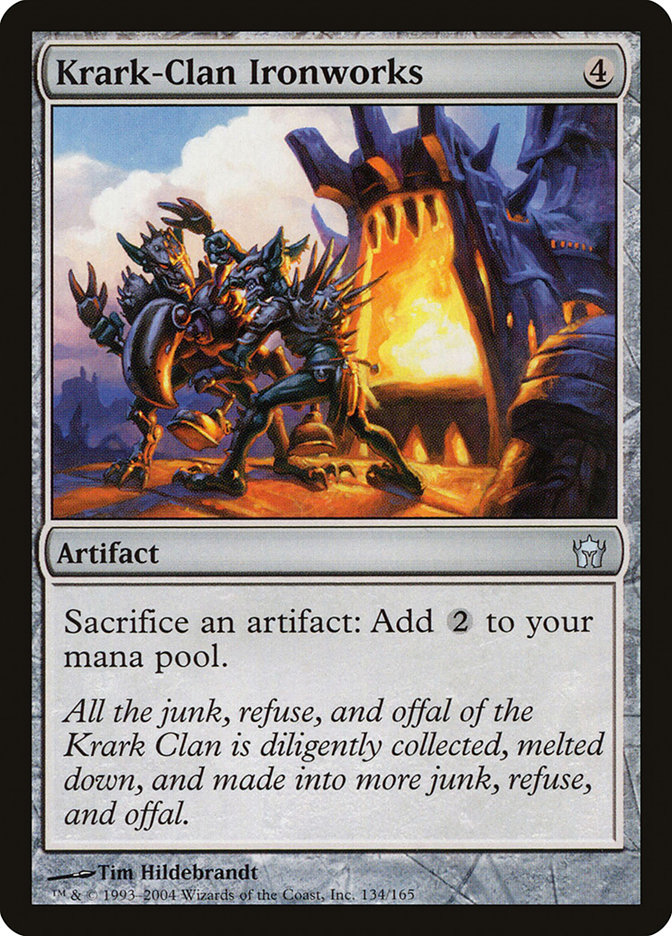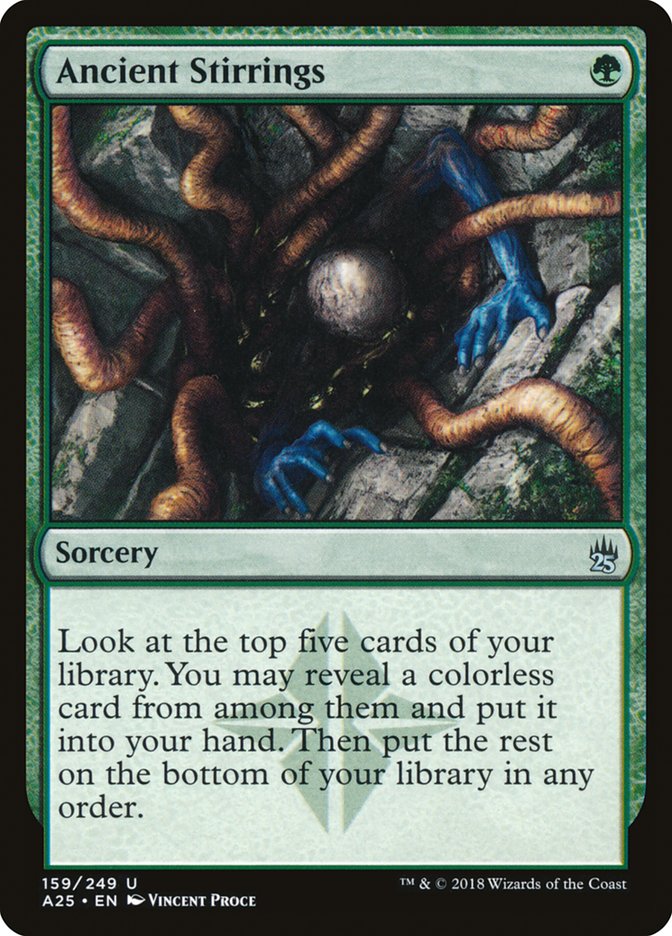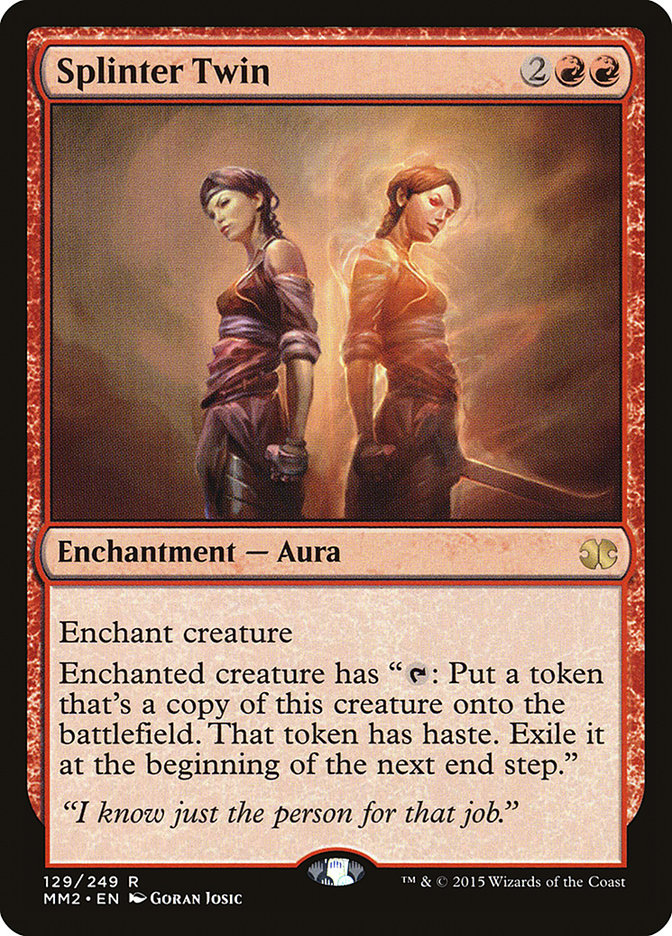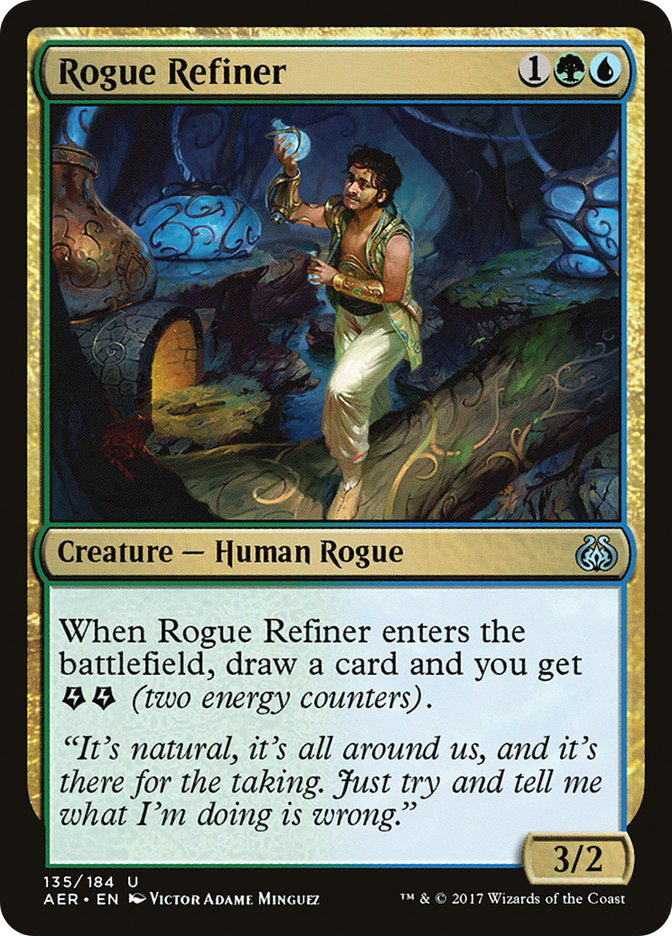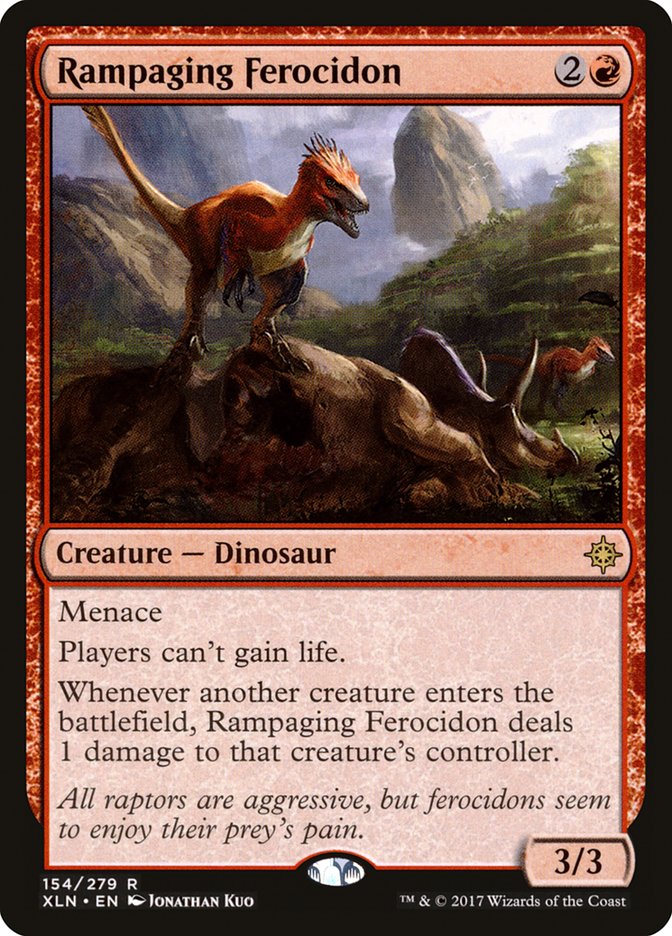Welcome to
Fact or Fiction!
This week, Ari Lax, Sam Black, and Jim Davis take on five pressing
questions about Monday’s Banned & Restricted announcement by
Wizards of the Coast. Read their answers and vote for the winner in the
poll at the end!
1. Krark-Clan Ironworks should have been banned in today’s
B&R announcement.
Ari Lax: Fiction.
Ironworks is one of the best decks in Modern, but that’s not inherently
bad. Combo decks are always going to have a place in non-rotating formats.
Ironworks can take a while to combo off, but that’s rare. Those are the
games a bunch of things just go a bit wrong and somehow you can’t find one
of the many deterministic infinite combos. Or maybe you just missed that
you had one, and people playing bad is hardly a reason to ban the deck.
Ironworks was oppressive, but people are beating it now. There’s more
copies of Stony Silence, more decks that understand racing plus a Shatter
works better than tons of answers. People adapted. Ironworks is fine even
if it does many stupid things.
Sam Black: Fiction.
There’s no evidence that this deck is a problem in Modern. The team that
finished best with it at #SCGDFW finished 17th, and one player made the top
8 (and another ninth) in the Classic. It’s a good deck, not a glass cannon
that was just a blip on the radar, but there’s no evidence that it’s
oppressive.
After sitting next to Matt Nass playing it at the Pro Tour and watching him
get destroyed by everything from Tron to a burn deck that started the game
with four cards, I can say that the deck is certainly beatable and it plays
interactive games of Magic for a combo deck. After sideboarding, he had
counterspells and removal, and opponents could attack his hand, the stack,
creatures, artifacts, or graveyards to make things harder for him. Sideways
hate cards like Relic of Progenitus were effective; they didn’t win the
game, but they did slow him down, which is a great spot to be. Almost any
kind of interaction can matter and there are dedicated cards that matter a
lot.
The deck is especially weak against prepared opponents doing things it
doesn’t expect. Matt got crushed by a Surgical Extraction out of Tron. As
players get a better idea of how the deck plays and what the relevant ways
to disrupt it are, it’s not clear as to whether it will settle into the
format as a tier one or tier two deck, but the play pattern is interactive,
the power level is appropriate, and concerns that it will extend round
length in a meaningful way seem totally baseless/unfounded to me. Yes,
there are some people who just don’t like playing against combo decks, but
I don’t know of any metric by which playing against Ironworks is a worse
experience than playing against Storm.
Moreover, I think banning Krark-Clan Ironworks sets a horrible precedent
that new decks are likely to be banned, which discourages innovation, and
more importantly, discourages buying into a new deck that comes up. Magic
is ultimately about selling cards, and people make money off Magic when a
new deck comes out and large numbers of players buy the new deck. If you
punish them by preemptively banning the deck just after it peaks, before
the format has had time to react, players will be a lot more gunshy about
buying new cards, and Wizards can’t afford that. Decks should only get
banned for power level if they survive multiple seasons or truly destroy
diversity.
Jim Davis: Fact.
Ironworks should not be a deck in Modern.
Krark-Clan Ironworks is a lot different than something like Golgari
Grave-Troll or Splinter Twin, which are fairly straightforward cards in
what they do. Both of those cards are banned based almost solely on power
level concerns, but Krark-Clan Ironworks twists power level concerns and
then adds on two additional layers as well.
On a power level perspective, I think Ironworks is actually just a broken
deck, but it’s so obscenely difficult to play that very few players are
able to play it anywhere near its potential level. The ones that do (Matt
Nass, for example) routinely crush with the deck, but learning curve keeps
most others away.
However, it’s not just about power level. The Eggs deck based around Second
Sunrise was a similar deck in Magic’s history that got banned mostly
because it was so obnoxious. Combo turns would routinely take ten or more
minutes, providing an awful play experience and holding up tournaments.
These sorts of non-power level issues matter and are very much in play.
Lastly, the deck abuses the rules in weird ways that are not immediately
intuitive. Being able to announce spells and over pay mana into Chromatic
Star, executing weird loops… it’s just a disaster that’s very hard to
explain to anyone not intimately familiar to the deck, and that’s the kind
of thing that’s going to sour a player who is playing their first Modern
event with their brand-new Burn deck.
Emma Handy already
wrote a fantastic article
about why Ironworks needs to go, which is highly recommended further
reading on the subject, but that fact is Ironworks needs to go. Hitting
Krark-Clan Ironworks is the most direct way of doing that, but there are
other options…
2.Ancient Stirrings should have been banned in today’s B&R
announcement.
Ari Lax: Fiction.
If you wanted to ban Ancient Stirring, the time was seven years ago. Now it
just supports a bunch of unique decks in Modern and removing it takes out a
beloved pillar of the metagame that isn’t actively trashing the format.
Unlike previous arguments like this, usually protecting Brainstorm, Ancient
Stirrings makes you work for it. Sure, playing Mox Opal isn’t that much
work, but this is a case of restrictions breeding creativity. Powerful
unconditional cantrips lead to stacks of the best cards. Forcing people to
play specific and some suboptimal cards to play a good cantrip makes it
easier for different decks to coexist. Mono-Green Tron, Hardened Scales
Affinity, and Ironworks all have merits and aren’t a Four-Color Delver
convergence.
If anything should be banned its Mox Opal, but that “not if but when” has a
long fuse until the next artifact set.
Sam Black:
Fiction.
I stand by everything I said in my last article on
this topic
.
The fundamental point is the same here as with Krark-Clan Ironworks; I
don’t think action should be taken against that deck and there’s nothing
particularly problematic about the other Ancient Stirrings decks at the
moment. If anything, they’re mostly weaker because more people are prepared
to fight against artifacts because of Ironworks.
Jim Davis: Fiction, assuming that Krark-Clan Ironworks is banned.
I’m flip-flopping a bit here, as I’ve said often lately that I felt it was
Ancient Stirrings time to go but let me explain.
Ancient Stirrings is right on the edge, but what’s pushing it off the cliff
is its association with Krark-Clan Ironworks. As I said above, Ironworks
must go, and if Ancient Stirrings or Mox Opal has to pay the price for that
to happen, I’m okay with that. Realistically, I’m happier just hitting
Krark-Clan Ironworks directly and letting Ancient Stirrings stay on the
watch list.
While it does fuel some obnoxious strategies like Tron and Lantern Control,
I like the idea of the best Ponder effect in the format being both green
and uniquely restricted and am willing to see Ancient Stirrings in an
Ironworks-free world before taking action.
3. Stoneforge Mystic should have been unbanned in today’s B&R
announcement.
Ari Lax: Fiction.
People like to cite that Jace, the Mind Sculptor and Bloodbraid Elf have
been fine in Modern and that Stoneforge Mystic is from the same era of
fears. First of all, Bloodbraid Elf and Jace are both really dumb in
Modern. If Stoneforge Mystic is exactly as good as they are that’s a big
deal.
Second, Stoneforge Mystic costs two, not four. The potential window for
counterplay is so much shorter, and the literal cost of casting it and the
figurative cost of inclusion are low.
Finally, Stoneforge Mystic stands alone. You need a deck for Jace and
Bloodbraid Elf. You need two copies of Batterskull for Stoneforge Mystic.
If Modern now is a lot about presenting multiple broken angles of attack in
your deck, what do you think would happen if four Stoneforge Mystic, two
Batterskull just added one of those angles to your deck?
Sam Black: Fiction
. This question has been brought up enough that I’m getting closer to being
on the fence about it. It’s possible that we’re getting to the point where
it would be a useful tool against Humans, but I still worry about it really
taking over the format, as it’s so easy to include in basically any kind of
deck, so comparisons to two-mana build around creatures are absurd. We’d
see U/W Delver with Stoneforge, U/W Control with Stoneforge, Mardu
Stoneforge (over Young Pyromancer), Death and Taxes with Stoneforge,
Stoneforge Company; at the moment, all the creature decks play different
creatures, and that’s pretty sweet. I think it would be worse if every
white deck attacked in the same way.
The opportunity cost to play Stoneforge Mystic is too low, and so little
can go wrong if you put it in your deck. You invest two mana. Best case for
your opponent, they spend a mana answering it and you’re up a card. Real
best case for your opponent might be they spend a mana to make you discard
the equipment and you’re left with a 1/2, and now you don’t have an
equipment you expected to always have access to when you built your deck,
but there’s no Cabal Therapy to really cleanly answer the card in hand.
(Side note: I absolutely love the way Cabal Therapy functions as Stoneforge
Mystic hate.)
Nah, every time I really think about it, I move from, “Okay, maybe people
have a point; it doesn’t lead to turn 4 kills, it makes people try to play
longer, more interactive games and that’s probably good” to, “No, this is
stupid, the card’s too strong and too many games would have to revolve
around it in a way that’s too repetitive to be fun and too powerful to
contribute to diversity.” I know I listed a lot of different possible
Stoneforge decks, but some would be dismissed as worse than others and
there’s a huge chance they’d push too many other decks out of the format.
Jim Davis: Fact.
This one’s a risk, but I like erring towards giving things a chance and
seeing how it plays out. While rebanning a card is not ideal, it is a very
real failsafe to have in the event that things go horribly wrong (as we saw
with Golgari Grave-Troll). I’m also not completely convinced the risk is
that bad.
Stoneforge Mystic isn’t Summer Bloom or Krark-Klan Ironworks. It’s not a
busted combo card that’s going to end the game super early or create unfair
gamestates. The fear with Stoneforge Mystic is that it becomes the
ubiquitous fair threat in the format and homogenizes how all fair decks are
built.
Is this fear realistic? Maybe, but given both the relative failure of
Bloodbraid Elf and Jace, the Mind Sculptor as well as the many new tools
that are naturally good against Stoneforge Mystic (Kolagan’s Command, Fatal
Push, etc), I’m ready to give it a shot. Modern is full of busted decks
that could care less about a turn 3 Batterskull, and I’m pretty happy
giving fair decks a new toy.
4. Splinter Twin should have been unbanned in today’s B&R
announcement.
Ari Lax: Fiction.
Splinter Twin just isn’t fun.
There’s exactly one thing it does. We know it isn’t fun. We know it would
probably be one of the best decks. It is really paralyzing for players to
approach in and out of game. When you see R/B Vengevine, you get that you
show up with graveyard hate. With Twin, you don’t get that the best plan is
ignore it and cross your fingers, which also still sucks.
Unbanning it is like pining for your ex. Like, you banned it for a reason
the first time. The answer to any minor problem isn’t reverting to a
different situation you also know wasn’t great.
Sam Black: Fiction.
Absolutely not. As I see it, the Golden Age of Modern started with that
card’s banning. To me, that’s when the format became the great, diverse
format it is today.
The play pattern of Splinter Twin is atrocious. Your opponent has to waste
mana every turn so that you can’t instantly kill them and you don’t, so
just by playing the deck you’re playing, you get ahead on mana every turn,
so your opponent often can’t really try to play around it and often just
has to ask if you have it. Every time you do, it’s just not a good game of
Magic with a conclusion that wasn’t particularly satisfying.
It pushes more decks out of the format than any other deck because every
deck must include lots of cheap instant ways to interact with creatures.
Yes, it’s fine to ask people to have a plan to answer creatures, but when
every plan must be cheap instants, there’s no room for any other creature
removal. People can’t play sweepers and they can’t play decks that are just
trying to do their own thing because their thing is worse than Twin.
Moreover, the deck simply won too much, and there’s no reason that wouldn’t
still be true. It’s very hard for me to imagine anyone in the “legalize
Splinter Twin” camp who didn’t like it exclusively because they think they
win more matches when it’s legal than when it isn’t, most likely because
they’re Twin players who won because the deck was too strong. Maybe a few
people had pet decks that happened to have a good Twin matchup.
Jim Davis: Fiction.
Ah Splinter Twin, every Spike’s favorite deck and the “fair” combo deck. If
you’re afraid of Stoneforge Mystic having a homogenizing effect on the
format, you should be terrified of Splinter Twin.
When Splinter Twin was banned, most hyper competitive Magic players were
very vocally upset. Splinter Twin was considered the gatekeeper of Modern,
keeping all the random garbage decks in check and the format somewhat
interactive. That was then, and now Modern is the most popular format by a
wide margin because everyone loves their random garbage decks!
There are definitely cards on the banned list that should not be there, and
Wizards of the Coast has done a very good job of culling them off the list
in the last few years (think Ancestral Vision, Bitterblossom, etc.)
However, there is certainly a hierarchy, and Splinter Twin is a high bar.
We’ve been getting there with Jace, the Mind Sculptor and Bloodbraid Elf
recently, but we’ve got a few more to get through (Stoneforge Mystic most
notably) before it’s time to discuss Splinter Twin.
Maybe someday, but certainly not yet.
5. You would have unbanned something from the Standard banned
list to make the World Championships more interesting.
Ari Lax: Fiction.
All the outcomes are bad here.
If you unban something and it doesn’t matter, everyone is bored. If you
unban something and it’s broken, the format is lame to watch and everyone
is reminded what a bad mistake Aetherworks Marvel was. But the worst might
be unbanning something and having a cool outcome. Because that just shows
you messed up and everyone missed out.
Regardless, it’s a format no one at home can play and therefore, no one
cares about. You may as well ask them to play Prophecy-Dragon’s Maze-Homelands Singleton and draft the Silver
Showcase format, but reverse pack order this time.
Sam Black: Fiction.
This is an interesting solution to a pretty real problem that the timing of
Worlds is awful and the formats aren’t interesting. The problem is that I
don’t think it solves the problem, because competitors are still playing a
format viewers aren’t incentivized to personally care about. I worry that
the optics on “Watch this goofy exhibition format” or “see what could have
been” are worse than “watch the culmination of Standard before rotation.”
From a historical perspective, it’s actually kind of cool for Worlds to
happen at the very end of a Standard format, right before rotation, because
that means the decks from Worlds will be from when Standard was at its
biggest, so they’ll be the most powerful decks from this era of Standard,
which makes for good history when thinking about things like throwback
gauntlets. If the decks are taken from earlier in the cycle, before cards
that made them better are printed, players could be disappointed that it
doesn’t have a good card they remembered; someone might get a Ghalta deck
from before Core Set 2019 and wonder why it doesn’t have Vine
Mare. “It wasn’t printed yet.” “Oh, that’s stupid, why wasn’t a list chosen
from after it was printed?” Now, the highest profile event has the best
decks with the best cards.
I think it’s cool to have wacky exhibition events that test players’
ability to adapt to new things, but to me it feels fitting for Worlds to
test players “in optimal conditions,” not “how much time can you set aside
to figure things out on a crunch.” When you have the benefit of all the
time and all the data and all the best cards, what can you come up with?
This is the only way that it tests both the cards and the players, so it
can feel like it’s settling the debate about what the best deck in this
format really was while also crowning a champion on play skill. I think
there’s something to that narrative that makes a more satisfying story than
throwing a curveball just to throw a curveball.
Jim Davis: Fiction.
I like how this question is worded a lot, because I think unbanning stuff
is much more preferable to banning stuff (as we are seeing in Modern).
Standard is not perfect right now, but I most certainly wouldn’t ban
anything because of the major baggage that comes with that (
that I’ve written about numerous times
). Unbanning things is a much more tenable way to shake up the format.
The question is, does the format need shaking up? Frankly, Standard looks
incredibly healthy at the moment. The results from the last few GPs as well
as the standard portion of #SCGDFW make this pretty clean, and having
played both the Standard seat at #SCGDFW as well as GP Orlando I can say I
played against a wide variety of decks and am completely unsure what the
best deck is at the moment.
That’s awesome, and as such, no movement is necessary.


